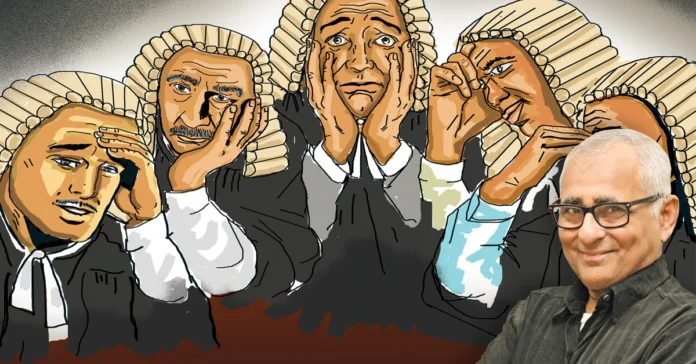By Inderjit Badhwar
The Indian judiciary, and the Supreme Court in particular, is often described as the ultimate guardian of the Constitution. Its judgments ripple outward, shaping laws, rights, and the very idea of justice in the world’s largest democracy. It is no exaggeration to say that who sits on that bench determines not just the interpretation of law, but the fate of countless citizens. That is why our cover story this week—on the latest round of judicial appointments to the Supreme Court—strikes at the heart of an issue that has troubled governments, judges, and the public for decades: who judges the judges?
With the elevation of three new High Court judges recently, the Supreme Court now has its full complement of 34 justices. On the surface, this is welcome news. For years, vacancies have clogged the system, delayed hearings, and placed an impossible burden on sitting judges. But as our cover story by Dilip Bobb makes clear, the larger issue is not about filling chairs, but about how those chairs are filled. The Collegium system, created by judicial precedent rather than by the Constitution, remains one of the most secretive and hotly debated institutions in our democracy.
On paper, the Collegium’s criteria are clear and rational: seniority, merit, integrity, diversity of gender, community, and region. In practice, however, the system often appears to fall short of its own standards. The latest appointments are a case in point. While the judges elevated may all have strong reputations, glaring imbalances persist. There is now just one woman judge on the Supreme Court bench, a shocking reality three decades after Justice Fathima Beevi first broke the gender barrier. There is only one Muslim judge, one Dalit judge, and no representation from several states whose High Courts have long been overlooked.
This is not a matter of tokenism. Diversity on the bench is not a box-ticking exercise; it is a democratic necessity. A Court that interprets the Constitution for 1.4 billion people must reflect that diversity in its composition. When whole sections of Indian society, whether by gender, caste, community, or geography, see no one who looks like them or understands their lived reality on the nation’s highest bench, the Court risks losing its credibility.
The Collegium’s defenders argue that merit must be paramount, and they are right. But merit cannot be divorced from fairness, representation, and transparency. That is why the debate has been so fierce. Parliament’s attempt to replace the Collegium with the National Judicial Appointments Commission (NJAC) in 2015 was struck down by the Supreme Court itself, in what is known as the Fourth Judges Case. The Court rightly ruled that executive interference would compromise judicial independence, a principle that is sacrosanct. Yet in reaffirming the Collegium, the Court admitted its flaws and promised to make the system more transparent. Ten years on, transparency remains elusive.
Part of the problem is the perception, voiced by no less than Justice Chelameswar, that the Collegium is a “euphemism for nepotism”, where mediocrity is sometimes rewarded and merit overlooked. This perception, whether exaggerated or not, undermines public trust. It also feeds into a larger anxiety: that the judiciary, meant to be the most impartial pillar of democracy, is in danger of becoming an insular club.
Our cover story does more than document the latest round of appointments; it places them in the historical arc of the Four Judges Cases that created, expanded, defended, and reshaped the Collegium system. It highlights dissenting voices within the system itself—Justice Nagarathna’s objections to the proposed elevation of a colleague, for example, or Justice Surya Kant’s reminder that persuasion and guidance are better than castigation. These are not just internal squabbles; they are signs of a system wrestling with its own contradictions.
What is at stake here is not only the legitimacy of the Collegium, but also the health of our democracy. In an era when trust in institutions is fraying—whether Parliament, political parties, or the media—the Supreme Court must remain beyond reproach. Its credibility is its only currency. Every appointment that raises doubts about fairness or inclusivity chips away at that currency.
At the same time, we must acknowledge the delicate balance the judiciary must maintain. Too much executive control, and independence is lost. Too little transparency, and accountability is sacrificed. That balance has never been easy to achieve. But if the judiciary is to live up to its role as the sentinel of our Constitution, it must find ways to reform itself, to broaden its vision of merit, and to ensure that the Supreme Court belongs not to a narrow elite, but to the entire nation.
The appointment of three new judges may seem routine, a bureaucratic process of replenishing numbers. But as our cover story shows, each appointment carries the weight of history and the burden of public expectation. Who sits on the Supreme Court bench will shape not only the law, but also the future of India itself.
That is why this debate matters. That is why it belongs on our cover.


